































 Ronwen Williams
Ronwen Williams







Commitment, discipline, humility and consistency are key for this goalkeeping hero




















WHAT IS POST-PARTUM THYROIDITIS?
SOUTH AFRICAN INFORMED INNOVATIVE INSPIRED WELCOME HOME
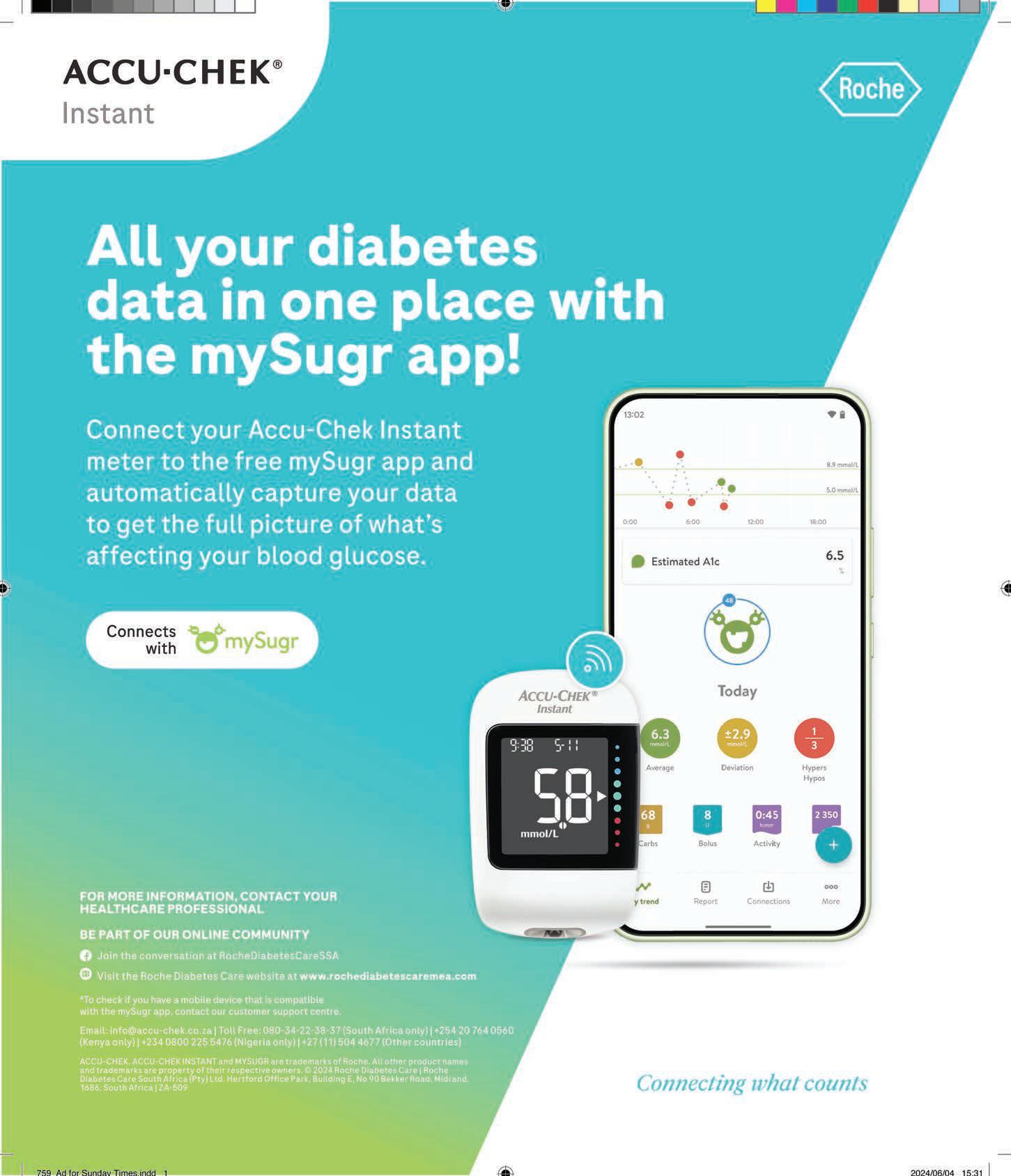







Making some lifestyle changes and using the correct medication can help you better manage diabetes and improve your health.
MYTH #3: NO FAMILY HISTORY, NO WORRIES
The truth: many people with diabetes have no close family members with diabetes. While you may not have a family history, lifestyle choices can increase your risk for type 2 diabetes. You can help counter that by staying active, eating well and maintaining a healthy weight.

THE TRUTH BEHIND DIABETES MYTHS
Managing diabetes can be challenging enough without having to deal with incorrect information.
Roche Diabetes Care takes a closer look at some common myths about diabetes and the truth behind them
MYTH #1: TYPE 1 AND TYPE 2 DIABETES ARE THE SAME
The truth: while both types are linked to insulin, the diseases are very different. Type 1 diabetes is an autoimmune disease in which the body stops making insulin. People with type 2 diabetes make insulin, but their body’s cells can’t use it, according to the Diabetes Atlas Report from the International Diabetes Federation.
MYTH #2: DIABETES ISN’T A SERIOUS DISEASE
The truth: diabetes is the second overall leading cause of death in South Africa, as revealed in Statistics South Africa’s Mortality and causes of death in South Africa: Findings from death notification report. The good news is that making some lifestyle changes and using the correct medication can help you better manage diabetes and improve your health.
MYTH #4: CARBS ARE BAD FOR DIABETES
The truth: carbohydrates are part of any healthy diet, whether you have diabetes or not. Yes, carbs affect blood sugar levels. But not all carbs are created equal. Whole grains (for example, brown rice or wholewheat bread), fruits and vegetables are important sources of vitamins, minerals and fibre. So choose more of those carbs. And try to stay away from starchy, sugary or refined carbs.

MYTH #5: I DON’T NEED TO CHECK MY BLOOD SUGAR
The truth: monitoring your blood sugar is the only way to ensure your blood sugar levels stay within your target range. Depending on your unique treatment plan, you may need to check your blood sugar once a day or multiple times a day, according to the American Diabetes Association (ADA) Standards of Medical Care in Diabetes. If you are already checking your blood sugar, make sure you are doing so regularly and consistently, according to your doctor’s recommendation. This will ensure that your doctor gets all the information he or she needs to make the best treatment decisions for you.
If you still have questions, please contact your doctor or the nearest clinic to get more information on better managing diabetes.
Information provided is void of any representation and warranty as to the reliability, accuracy, timeliness, adequacy, or suitability of the information provided and is not a substitute for professional medical expertise or treatment for medical conditions, actions, applications of medication. For personalised medical advice, consult a doctor or other appropriate medical professional, always seek advice from physicians/doctors for queries regarding any medical conditions.


HEALTHY TIMES l 1
image: supplied
BETESCARE
ROCHEDIA
ROCHE DIABETES CARE ADVERTORIAL


HEALTH, WEALTH AND GAP COVER
Turnberry
Management Risk Solutions
shares advice on adopting a holistic approach to wellness and financial security

hile embracing a healthy lifestyle can boost longevity and wellbeing, unforeseen accidents and illnesses can strike anyone, anytime. Even the most physically fit individuals may face medical expenses beyond their means. In such situations, having comprehensive coverage becomes imperative. Here’s why you need to prioritise your health and financial security.
In the past year, Turnberry Management Risk Solutions saw an increase in the number of medical expense shortfalls, in excess of R100 000 for various conditions. Examples include shortfalls of R128 485 for a polyp of the nasal cavity, R113 867 for a spinal disc disorder, R104 733 for cancer of connective and soft tissue, R102 874 for a heart condition and R102 592 for spinal stenosis. There were also numerous claims ranging between R60 000 and R100 000 for heart disease, cancer and spinal disorders to chronic sinusitis and abscesses.
BENEFITS OF HEALTHY LIVING
Regular exercise and a balanced diet are cornerstones of good health. They not only enhance cardiovascular health, but also bolster brain function, aid weight management and reduce the risk of various diseases. Moreover, maintaining a healthy lifestyle can slow ageing, strengthen bones and muscles and boost overall vitality. However, being health-conscious doesn’t render you immune to medical conditions, therefore adequate medical coverage is crucial.
THE HIGH COST OF HEALTH
Underestimating the potential financial burden of healthcare can be detrimental. Even with medical aid, significant out-of-pocket expenses often arise, including surgeon fees, hospital charges and co-payments. Without proper coverage, these expenses can escalate into financial ruin, exceeding tens or even hundreds of thousands of rands.
ROLE OF GAP COVER
Enter gap cover – a complementary product to medical schemes. It bridges the chasm between medical aid coverage and actual expenses, safeguarding individuals from hefty shortfalls. Gap cover comes into play when specialists charge beyond the limits of medical scheme rates – it provides relief for medical expenses not fully covered.
UNDERSTANDING GAP COVER
Gap cover operates within an annual limit, currently R198 660.43 per insured person. This coverage extends to the principal insured, their spouse and eligible children. Depending on the policy, it may include extended family members for




an additional premium. Gap cover primarily addresses shortfalls resulting from the variance between medical scheme coverage levels and specialist charges. In some cases, Turnberry has paid an accumulated amount exceeding R500 000 over the lifetime of various policies.
COMPREHENSIVE PROTECTION
In addition to shortfalls, gap cover addresses co-payments and penalties incurred for using nondesignated service provider hospitals. Some policies even offer waivers in the event of the principal member’s demise. However, it’s crucial to note that gap cover only supplements existing medical scheme benefits – it doesn’t cover expenses not included in the scheme.
SECURING YOUR FUTURE
To achieve a balance between health and financial wellbeing, strategic planning is essential. A financial advisor can help tailor a comprehensive portfolio, integrating investments and relevant insurance policies to protect both health and wealth effectively.
Your health and financial wellbeing are intertwined. By adopting a holistic approach that includes maintaining a healthy lifestyle and securing adequate insurance coverage, you can pave the way for a longer, healthier and financially stable future.
TAKE ACTION NOW
Apply for Turnberry gap cover by contacting your financial advisor or us on 011 677 9891 to refer you to one. You can also apply online by completing the digital application at https://getcovered.turnberry.co.za/app/1. For more information, consult the Turnberry website: www.turnberry.co.za
ABOUT TURNBERRY MANAGEMENT RISK SOLUTIONS
Founded in 2001, Turnberry is a registered financial services provider (FSP no. 36571), specialising in accident and health insurance, travel insurance and funeral cover, underwritten by Lombard Insurance Company Limited, an Authorised Financial Services Provider (FSP 1596) and Insurer, conducting non-life insurance business.
Turnberry’s gap cover products are available to clients on all medical aid schemes as they are provided independently and are therefore transferable in the event of a change in the client’s medical aid scheme.





HEALTHY TIMES l 3
TURNBERRY GAPCOVER
image: supplied
TURNBERRY MANAGEMENT RISK SOLUTIONS ADVERTORIAL

PUBLISHED BY

Picasso Headline, a proud division of Arena Holdings Pty (Ltd), Hill on Empire, 16 Empire Road (cnr Hillside Road), Parktown, Johannesburg, 2193 PO Box 12500, Mill Street, Cape Town, 8010 www.businessmediamags.co.za
EDITORIAL
Content Manager: Raina Julies rainaj@picasso.co.za
Contributors: Dr Justus Apffelstaedt, Reo Botes, Murray Hewlett, Mbali Mapholi, Nkareng Matshe, Leko Nkabinde, Elani van Zyl
Copy Editor: Brenda Bryden
Content Co-ordinator: Natasha Maneveldt
Digital Editor: Stacey Visser
DESIGN
Head of Design: Jayne Macé-Ferguson
Senior Design: Mfundo Archie Ndzo
Advert Designer: Bulelwa Sotashe
Cover Image: galloimages.co.za/Lefty Shivambu
SALES
Project Manager: Arnold Cruywagen arnoldc@picasso.co.za | +27 21 469 2508 +27 71 012 5286
Sales: Gavin Payne
PRODUCTION
Production Editor: Shamiela Brenner
Subscriptions and Distribution: Fatima Dramat, fatamid@picasso.co.za
Printer: CTP Printers, Cape Town
MANAGEMENT
Management Accountant: Deidre Musha
Business Manager: Lodewyk van der Walt General Manager, Magazines: Jocelyne Bayer


Disclaimer:


While every effort has been made to ensure that the information in this publication is sound, it is expressly not designed to diagnose or treat a medical condition or health problem. The information does not constitute medical advice. It is also subject to personal interpretation and may become dated or obsolete. The publisher, editor, authors and their employees or agents, therefore, cannot accept responsibility for the information in this publication or for any errors, omissions or inaccuracies contained therein, whether arising from negligence or otherwise. They are therefore not liable for any direct or indirect effects of the information. Please consult a qualified healthcare practitioner regarding any medical or health issues.
contents

7 COVER PROFILE
Goalkeeper Ronwen Williams shares what he does to stay mentally and physically t and grounded.
10 GENERAL HEALTH
Understanding your bladder; Nutrition for peak performance at every stage of life; Why the u vaccine is the best available form of protection against in uenza.
13 BOOKS
Positively Me by Nozibele Mayaba.

20 BREAST HEALTH
Breast cancer impacts countless women around the globe, manifesting in various types, each distinct in nature and requiring different treatments. Among these, triple-negative breast cancer stands out.
21 PREGNANCY HEALTH
Knowing the facts – an expert answers some frequently asked questions regarding post-partum thyroiditis.

23 SKIN HEALTH
Exploring the ve key warning signs of melanoma you shouldn’t ignore, plus tips for protecting your skin and reducing your risk of skin cancer.

24 KIDS HEALTH
Five bene ts of early childhood dental visits; Common symptoms, prevention and treatment of ear infections; Eight tips for ying safely with children.
28 CONSUMER ADVICE
There is much confusion and misunderstanding around medical aid versus medical insurance and where hospital plans t in, making it dif cult to decide what the best solution is to meet your needs. We unpack what you need to consider.
Copyright: No portion of this magazine may be reproduced in any form without written consent of the publisher. The publisher is not responsible for unsolicited material. Healthy Times is published by Picasso Headline. The opinions expressed are not necessarily those of Picasso Headline. All advertisements/advertorials have been paid for and therefore do not carry any endorsement by the publisher. 28


HEALTHY TIMES l 5 Images: iStock.com, Portrait image: supplied
20 10 23
24
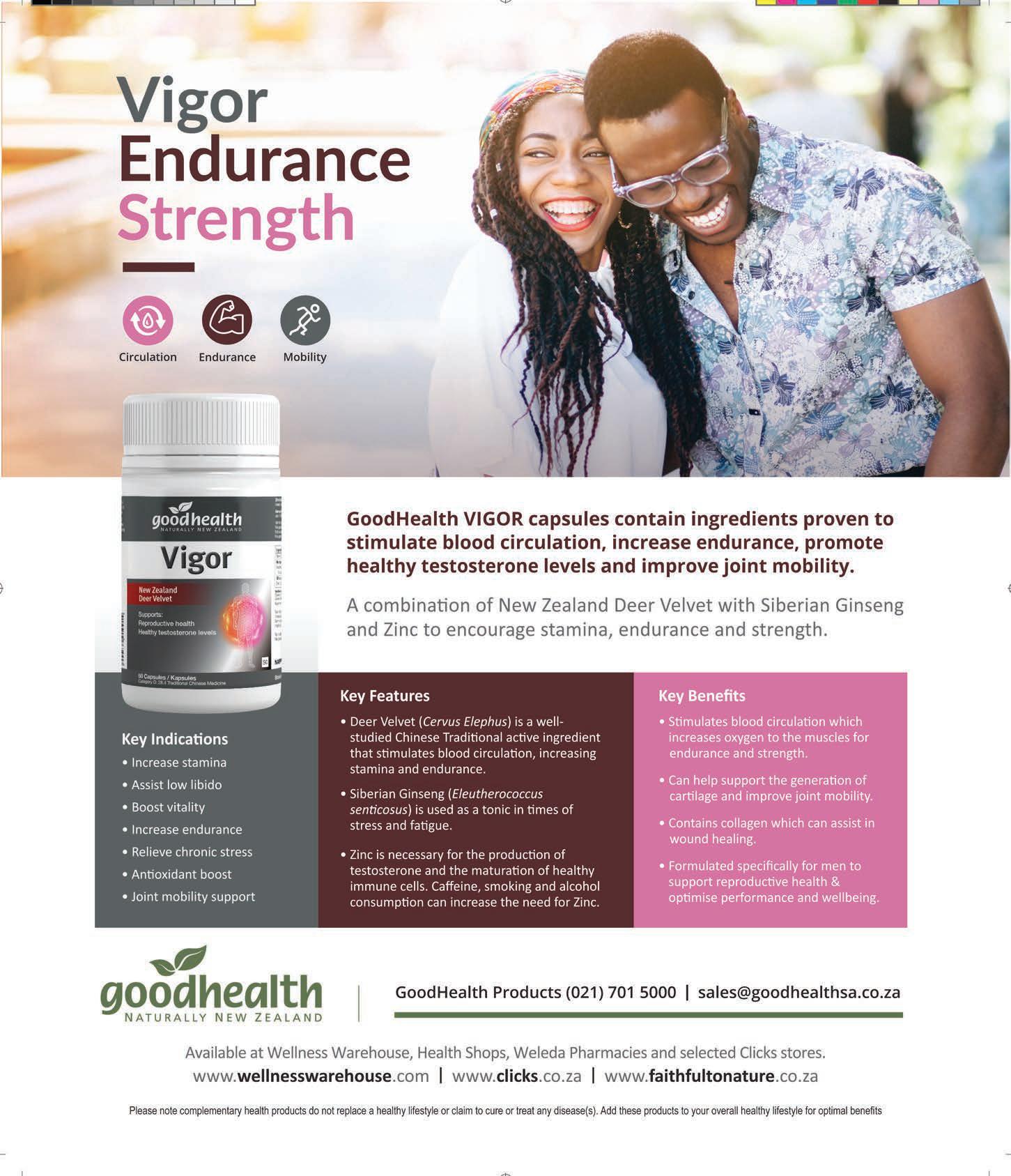


GETTING PERSONAL WITH MZANSI’S NO 1 GOALKEEPER


Nkareng Matshe, Sowetan sports editor, chats with Ronwen Williams about fitness, sacrifice and the weight of being a national hero

a
decade ago, Ronwen Williams experienced one of the most chastening evenings for a Bafana Bafana debutant. Brazil’s star-studded side, led by a rampaging Neymar, put South Africa to the sword in a friendly international at FNB Stadium, winning 5–0, in the process sowing doubt into the minds of many Bafana fans about Williams’s real potential as the country’s mooted No1 goalkeeper.


Fast forward to now: all those doubts have been banished and the torment Neymar – who netted a hat-trick – unleashed on a then-young Williams has long been forgotten.
Williams is not only the country’s best keeper at the moment, he’s also the continent’s undisputed No1 – after claiming the Golden Glove at the Africa Cup of Nations in Ivory Coast, where he captained Bafana to an impressive bronze medal.
SELF-SACRIFICE THE SECRET TO SUCCESS






HIS RISE TO PROMINENCE










Born in Gqeberha, Williams trekked to Gauteng as a teenager to join SuperSport United, with whom he made his professional debut in 2011. He signed for Sundowns in July 2022. The soccer bug inevitably bit him, he says, as “I was born into a football-loving family. I enjoyed watching my uncle, Mokes, playing in goal and, ironically, he was my coach in the amateur ranks, so the transition from playing infield to keeper was smooth”.
It has taken commitment, discipline and a consistent exercise regime to turn his fortunes around. While he doesn’t follow a set dietary plan, he knows what to eat and avoid to remain fit on- and off-season. “I try not to follow a strict routine for my daily meals, but typically, my day starts with an all-bran cereal, followed by lots of fruit throughout the day. For lunch, I’ll have chicken, and for supper, lots of pasta with chicken or meat,” the Mamelodi Sundowns keeper says.
Williams adds that avoiding alcohol and fizzy drinks can go a long way in enhancing a professional sportsman’s fitness. “You need to avoid drinks with lots of sugar,” he says.
Sundowns are known as the busiest team in the country, playing over 50 games almost every season, and top players such as Williams must stay fit throughout the year. “I do a gym session before we start training, then as keepers, we have our own run with the goalkeeper coach before we join the main session with the rest of the players,” he says, explaining his daily routine.
For that reason, Williams uses whatever limited time he gets to regenerate. “When we are in the off-season, I don’t exercise much because I must re-energise and sort out minor niggles and injuries,” the 32 year old says.
It has taken commitment, discipline and a consistent exercise regime to turn his fortunes around.
While he is now feted as a national hero following his Afcon exploits, where he famously became the first keeper to save four penalties in a Fifa tournament during the quarter-final win against Cape Verde, Williams has advised aspirant keepers to be aware of the perils that come with the demanding position. “Being a keeper is a lonely position. You must embrace being alone because there’s no one to save you. You have to improve daily and never think you’ve made it. Most keepers become better in the latter stages of their career,” he says.
Williams is undoubtedly at the peak of his career, having helped Sundowns to successive Premiership championships and voted goalkeeper of the season. But that moment when he strode onto the stage to pick up the Golden Glove as the best keeper on the continent stands out. “It was probably my greatest ever achievement. It still feels unreal but I’m so proud,” he says.
RAPID FIRE
Best way to relax? Spend time at home with my kids and partner. Best advice growing up? Don’t forget where you come from.
Favourite quote? Tables turn, bridges burn, you live and learn.
Advice to upcoming footballers? Don’t think you know it all, find ways to improve and don’t be scared to be different.
Favourite food/drink/clothing brand/car? Pasta and butter chicken, orange juice, Adidas and BMW 325i.
HEALTHY TIMES l 7
Image: galloimages.co.za/Lefty Shivambu
COVER PROFILE

Trusted, Affordable International PREMIUM HEALTH SUPPLEMENTS –supporting the South African lifestyle
Busy lifestyles mean we don’t have as much time to dedicate to self-care. When you’re not feeling at your best, or you’ve been pushing the limits, can be relied upon for help. Our premium supplements incorporate quality ingredients needed to help support our demanding lifestyles - whilst being safe and compliant with our regulatory requirements.

WHO IS NEW ZEALAND?
has been a clean-green New Zealand premium supplement brand since 1987 and is one of Australasia’s leading producers. Brand strengths are threefold:
• excellent high-strength formulations;
• using superior ingredient forms; and
• pharma-grade manufacturing compliance to strict local and international standards. Products are formulated by our naturopathic team who strongly believe in the benefits of herbs and nutraceuticals. Herbal medicine has been practised for thousands of years and today’s science enables us to prove much of “old wisdom” as factually relevant. All our hero ingredients are clinically researched, meaning product claims can be substantiated.
offers exciting supplement delivery forms – such as sublingual dissolving tablets, tasty chewables, easy-mix powders and direct-to-mouth granular sachets and liquids – making regular supplement taking easier and more enjoyable.
And our production facilities are GMP certified – the international recognition of quality manufacture with highly scrutinised raw ingredients. Our facilities are run along strictly pharmaceutical protocols by pharmacists and their quality assurance teams.
As proof of product quality and success, the brand supplies growth export markets such as Australia, China, Hong Kong, Indonesia, South Africa, South Korea and Vietnam.
IN SOUTH AFRICA
In 2001, the brand was launched in South Africa with our head office and distribution located in Cape Town. Health supplement importation and distribution
Our quality management team and responsible pharmacist control our regulatory compliance and product quality.
in South Africa requires approval and licensing by SAHPRA (South African Health Products Regulatory Authority), SAPC (South African Pharmacy Council) and NDOH (National Department of Health)
Our quality management team and responsible pharmacist control our regulatory compliance and product quality. Imported products are monitored during transit to South Africa and for temperature and humidity deviations while in our storage facility, ensuring what you buy in South Africa is the very same quality product manufactured in our New Zealand facility.
All products come with an attached Package Insert (called a PIL – the same as a pharmaceutical drug), outlining safety information, cautions and possible interactions.
SERVICE
In South Africa, we are a BEE compliant company offering high-level, professional service to our nationwide retailers and the public. Company representatives are qualified naturopaths, homeopaths or phytotherapists who understand the formulations and their application to the modern lifestyle. Reps visit retailers and practitioners on training calls, where on many occasions they interact with retail customers, helping them understand more about their own health and product choices. And 23 years on, can be found nationally at health shops, pharmacies, Wellness Warehouse, selected Clicks, Dis-Chem and Medirite+ stores and from Faithful to Nature and other quality online health platforms.
SATISFACTION GUARANTEE
We applaud South Africans who take the day-to-day maintenance of their health into their own hands by supplementing their diet with quality products – leaving visits to the GP only for those serious or repetitive illnesses. But in a world where so many companies take shortcuts, use inferior ingredients and make outrageous claims, it’s important to be able to identify authentic companies and trustworthy products.

If you’re not happy with your purchase – for any reason – just contact us or your retailer and return it for a refund. This is how we stand behind our quality product range.
Let become your supplement range of choice and we’ll walk the path to better health together!

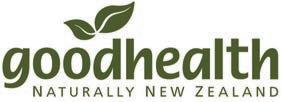

image: supplied
GOODHEALTH
HEALTHY TIMES l 9 GOOD HEALTH ADVERTORIAL




UNDERSTANDING YOUR BLADDER




bBladder infections are a common occurrence around the globe, but South Africans seem to be struggling more than most, writes Elani van Zyl, critical care product manager for Pharma Dynamics
ladder infections (cystitis) occur when tiny microbes travel up the urethra and into the bladder, causing an uncomfortable and painful infection in the lower urinary tract. While easily treatable, urinary tract infections (UTIs) can spread into your upper urinary tract and cause a host of problems, which is why a proper diagnosis early on is important.

Anatomically, women are more prone to UTIs since women have a shorter urethra than men.

Sexual activity can also introduce unwanted bacteria into the urinary tract since the urethra in women is much closer to the anus than in men, which makes it easier for bacteria to wind up in the bladder.
Mechanical contraception – spermicides, diaphragms and cervical caps – can also increase the risk of UTIs by altering the balance of bacteria in the vagina or by irritating the urinary tract.
In men, prostate problems can increase their risk of UTIs.
A swollen prostate can affect different parts of the urinary system, making it harder for urine to flow through the narrow tube. This can cause inflammation, which increases the risk of bacterial infection, leading to cystitis and/or prostatitis in men.
While the best treatment for UTIs is antibiotics, preventing urinary tract infections is crucial in the fight against antibiotic resistance and in ensuring these medications remain effective for treating bacterial infections.

Bladder infections occur when tiny microbes travel up the urethra and into the bladder, causing an uncomfortable and painful infection in the lower urinary tract.
PREVENTATIVE MEASURES
Here are some preventive measures against bladder infections or UTIs.
1. Stay hydrated: aim for around 6–8 glasses of water a day unless otherwise advised by a healthcare professional.
2. Maintain good hygiene: women should wipe from front to back after using the bathroom to prevent the spread of bacteria from the anus to the urethra. Keeping the genital area clean and dry helps prevent bacterial growth.
3. Urinate when needed: don’t hold urine for long periods as this can allow bacteria to multiply in the urinary tract. Empty your bladder regularly, especially after sexual intercourse.
4. Practise safe sex: using condoms during sexual intercourse can help reduce the risk of introducing bacteria into the urinary tract. Urinating before and after intercourse may also help flush out bacteria.
5. Avoid irritating products: certain feminine hygiene sprays, douches or scented products may irritate the urethra and increase the risk of UTIs. Opt for mild, unscented products instead. Also, change nappies or incontinence pads promptly once soiled.
6. Wear breathable clothing: tight-fitting clothing, especially synthetic materials, can create a warm, moist environment that encourages bacterial growth. Wear breathable cotton underwear to help keep the genital area dry.
7. Boost your immune system: a healthy immune system helps fight off infections. Maintain a balanced diet, exercise regularly and get adequate sleep to support your immune system.
8. Manage underlying conditions: conditions such as diabetes can increase the risk of UTIs. Properly managing underlying health conditions can help lower the risk of infections.

10 l HEALTHY TIMES Images: iStock.com/PeopleImages, supplied
NUTRITION FOR PEAK PERFORMANCE AT DIFFERENT AGES


Tetley and Laager partner dietitian Mbali Mapholi shares that the body changes with age constantly and as a person ages, diets will need to adapt
there’s a reason a person in their 40s doesn’t have the same amount of energy as they did in their 20s, or why they can’t eat like they did as a teenager. As we proceed on the journey of life, we must adapt our diets according to the changing nutritional needs of our bodies. Many people don’t realise that embracing these transitions at each stage is pivotal for overall wellbeing. Society talks a lot about how our bodies change over time, but no one really talks about how our dietary needs change as we age.

HERE ARE A FEW DIETARY TIPS FOR EACH DECADE OF ADULT LIFE
20s: laying the foundation for adult nutrition
This is a pivotal decade that lays the groundwork for lifelong health, which means it’s crucial to address your specific nutritional needs.
• Prioritise lean proteins, such as eggs, chicken, fish, beans, dairy and nuts, with every meal to support robust muscle development.
• Integrate iron-rich foods, such as lean meats, legumes and fortified cereals, into your diet, ensuring optimal energy levels to prevent fatigue.
• Healthy plant fats sourced from avocados, nuts, nut butter and oils contribute to cognitive wellbeing and brain health.
• The inclusion of an array of fruits and vegetables not only provides essential vitamins and minerals, but also introduces powerful antioxidants that combat oxidative stress.
• Hydration remains paramount in your 20s as fluid needs increase. You can enhance your drinking water by infusing it with flavours such as lemon or orange, berries, cucumber and herbs. Experiment with homemade iced green teas, such as the flavoured Tetley green tea range or the flavoured Laager Rooibos teas, incorporating fruit slices and herbs for a refreshing twist.
30s: nurturing health and balance
Your 30s requires strategic nutritional choices to sustain energy levels and promote overall wellbeing. You must ensure consistent meals, aiming for at least three a day, to meet increased nutritional needs during this stage of life.
• Prioritise essential nutrients from whole grains, such as sorghum, couscous, beans, chickpeas, brown or seeded bread and brown rice, into your daily diet. These nutrient-dense foods provide a steady release of energy throughout the day
• Include lean proteins, such as chicken, lean red meat, eggs and fish, to support muscle health and provide necessary amino acids.



• Dietary fibre is important in your mid-30s so prioritise fibre-rich foods, such as vegetables and fruits, to aid digestion and support heart health.
• Your calcium needs increase, so include dairy or fortified plant-based alternatives to increase bone health. Integrating these foods into your diet supports long-term skeletal strength and resilience.
• Hydration is key in your 30s, but opt for teas with minimal or no caffeine, such as Laager Rooibos. You can also incorporate water-rich foods, for example, watermelon, cucumber and lettuce, to increase fluid intake.
40s: ambracing nutrient-rich choices
In your 40s, your metabolism may slow down, which means making nutrient-rich choices that support your evolving needs.
• You will need more omega-3 fatty acids for heart and joint health so include lean, protein foods rich in these essential fats. Oily fish such as salmon, pilchards and sardines provide abundant omega-3 fatty acids.
• Incorporate plant-based sources, for example, walnuts and chia seeds, into your diet to promote heart health and joint flexibility. Overall, lean protein-rich foods are pivotal for muscle maintenance, ensuring strength and vitality.
• Integrate fibre-rich grains into your morning routine, good examples include sorghum, oats and high-fibre brown bread. These choices not only support digestive health, but also maintain steady energy levels throughout the day.
• Colourful vegetables provide a diverse spectrum of vitamins, minerals and antioxidants. These nutrients are essential for overall health and wellbeing, serving as a foundation for robust immune function and cellular repair.
• Hydration is crucial for overall wellbeing, specifically joint health. Incorporate teas, such as Laager Green Rooibos and Tetley Green tea, which have anti-inflammatory properties and contribute to optimal fluid intake.
50s and beyond: promoting longevity
As you enter the golden years, prioritising a holistic nutritional approach becomes imperative for promoting longevity. Small, frequent meals can aid digestion and nutrient absorption, providing a steady release of energy throughout the day.
• Vitamin D is a key player in calcium absorption so incorporate fortified plant milks or dairy to safeguard bone health, mitigating the risk of osteoporosis
As we proceed on the journey of life, we must adapt our diets according to the changing nutritional needs of our bodies.
HEALTHY TIMES l 11 Images: iStock.com/mi-viri, Portrait image: supplied
Mbali Mapholi
GENERAL HEALTH
• Omega-3 fatty acids, found in fatty fish such as salmon, as well as nuts such as walnuts, are crucial for supporting brain health and cognitive function.
• Elevate your protein intake with eggs, fish, lean meats and plant-based proteins, for example, beans, chickpeas and lentils. Proteins play a pivotal role in muscle preservation, supporting overall strength and vitality.
• Eat fibre-rich foods to maintain digestive health and regulate blood sugar levels, reducing the risk of chronic conditions.
• Hydration is even more important, supporting wellbeing and addressing the increased prevalence of constipation. Teas, such as Laager Rooibos and Tetley Green, as well as water-rich foods, contribute to optimal fluid intake, ensuring your body functions optimally. Tetley Chamomile tea is also a great option for reducing anxiety and assisting with sleep.

SPECIAL CONSIDERATIONS: PREGNANCY AND MENOPAUSE
• Pregnancy requires a comprehensive focus on nutrient-dense foods rich in folic acid and iron. Leafy greens, fortified cereals and lean meats are essential for foetal development, while iron-rich choices, such as beans and lentils, prevent anaemia. During this stage, hydration is key but caffeine should be avoided. Laager Rooibos, with its range of flavours, is the perfect caffeine-free option and offers additional benefits.
• During menopause, the emphasis shifts towards maintaining hormonal balance. Prioritise phytoestrogen-rich foods, such as soy and flaxseed, to alleviate symptoms. Staying well-hydrated is important so incorporate herbal teas, such as Laager Rooibos and Tetley Chamomile, and water-rich foods to address changing needs.
IS INFLUENZA REALLY SOMETHING TO WORRY ABOUT?




Why the flu vaccine is the best available form of protection against influenza. By Abbot Laboratories

while more than 100 different viruses can cause a cold, influenza is caused by one of four viruses, namely types A, B, C and D, with the circulation of Influenza A and B causing seasonal outbreaks of the disease. Flu is characterised by an abrupt onset and could include chills, fever, headache, fatigue, weakness, along with chest discomfort and coughing, and sometimes a blocked or runny nose and sore throat.
An increased incidence of flu is generally associated with autumn and winter because the flu virus lives longer indoors and thrives in less humid conditions. The colder months also see people spend more time indoors and in closer contact with others, which leads to more inhalation of the virus or contraction through the eyes, nose or mouth.
Most people who get flu will recover in a period of between a few days and two weeks. The danger of flu is that some people may develop complications, such as pneumonia, which can be life-threatening.
According to the National Institute for Communicable Diseases, seasonal flu results in an estimated three to five million cases of severe illness, and about 290 000 to 650 000 deaths globally, with between 6 000 and 11 000 people in South Africa dying as a result of flu complications every year.
Approximately half of these deaths are in the elderly, with the highest rates of hospitalisation being in those 65 years and older, those with HIV and children less than five years of age. Pregnant women
Most people who get flu will recover in a period of between a few days and two weeks. The danger of flu is that some people may develop complications.


are also at an increased risk of hospitalisation and death from flu infections. Those with chronic illnesses, such as diabetes, lung disease, tuberculosis and heart disease, are also at increased risk of being hospitalised as a result of flu.
According to the World Health Organisation (WHO), vaccination is the best way to prevent the flu. Because flu viruses are constantly changing, flu vaccines are updated from one season to the next to protect against the viruses that research suggests will be common during the upcoming flu season.
With flu vaccinations being safe, effective and used for more than 60 years, the WHO recommends an annual flu vaccination, especially for those more at risk of flu complications, including pregnant women, children aged 6 months to 5 years of age, people over the age of 65, people with chronic medical conditions and health workers.
Even for those who are not at an increased risk of complications, an annual flu vaccination can prevent severe illness, reduce time off work or school, and help limit the spread of flu to loved ones and colleagues.
The flu vaccine works by stimulating the immune system to produce its own antibodies against the disease. Contrary to what some people may believe, none of the ingredients in the vaccine can cause actual flu.
Although the timing of the flu season varies from year to year in South Africa, it is generally most severe during the winter months of May to August, but can start as early as April or as late as July, with the average duration of the flu season lasting 19 weeks.
Flu vaccinations are currently available at most healthcare providers, pharmacies and clinics in South Africa.


12 l HEALTHY TIMES GENERAL HEALTH Image: iStock.com/Jacob Wackerhausen
MORE INFORMATION ON FLU PREVENTION READ NOW

INSPIRATIONAL AND POWERFUL



Positively Me by Nozibele Mayaba with Sue Nyathi is
a
personal
account
of learning
to
live with HIV and finding acceptance, purpose and love
the first part of Nozibele Mayaba’s book details her strict Christian upbringing in Gqherba. She shares that she constantly strived to be a “good girl” to receive her mother’s attention, be “claimed’ by her absent father, and praised by her teachers.

Her need for affirmation sets the theme for most of her life as she pursues a tertiary education and career. But then “Two pivotal, life-changing things would soon happen”, she writes in Chapter 5.
THE DIAGNOSIS
Nozibele meets her first love and despite sharing with him her strong Christian beliefs and determination not to have sex before marriage, she succumbs to his charms. Fast forward ... at a company wellness event, Nozibele takes an HIV test and tests positive.
Her boyfriend is unsympathetic, unconcerned and distant. Their relationship deteriorates, and when she discovers she is pregnant she terminates the pregnancy. This begins her downward spiral into depression, despair and, at times, suicidal thoughts.
FINDING HER PURPOSE
For years, she fights her demons alone, not revealing her HIV status to anyone. During that time, the boyfriend abandons her. Desperate to find herself again, Nozibele confides in a friend saying “I want to be happy. … I want to laugh without any care in the world. I want to be me again.” Her friend responds: “Sometimes our healing is in our pain.” So Nozibele opens herself to her pain, reveals her status and the healing begins. She realises she needs to share her story and so finds her purpose.
“Today I no longer look at the world and see judgement,” are among the closing words in this brave, honest book about what it means to dare to live and love beyond HIV.
Positively Me is published by Jonathan Ball Publishers and available at bookstores and online through Loot and Takealot


HEALTHY TIMES l 13 Credit: Text: Brenda Bryden, Image: Supplied
Nozibele Mayaba
FOLLOW
LIFE
ON YOUTUBE READ NOW BOOKS
NOZIBELE’S
AND LESSONS

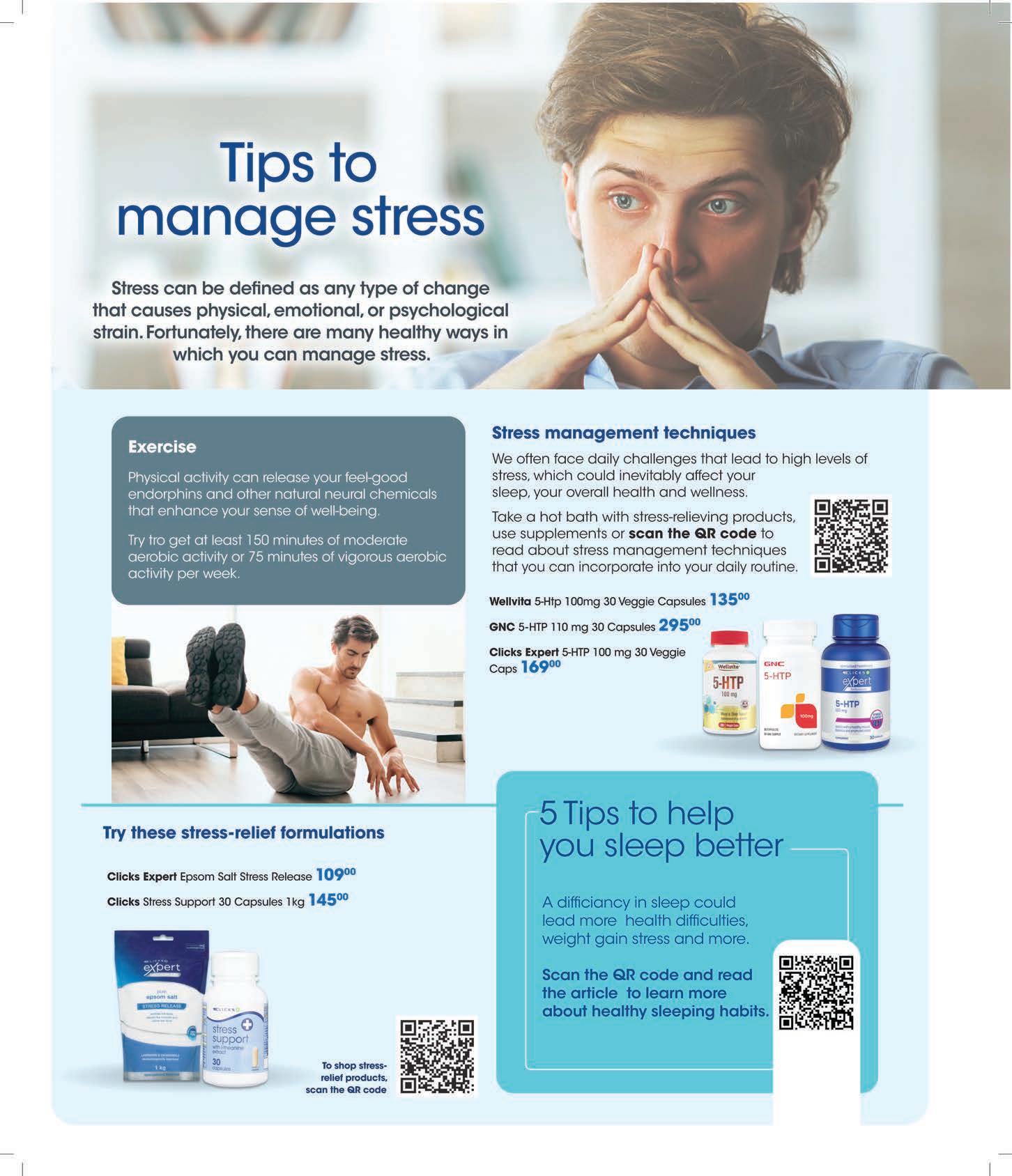







THE SCIENCE SIMPLIFIED Getting to grips with triple-negative breast cancer



Breast cancer impacts countless women around the globe, manifesting as various types, each distinct in nature and requiring different treatments. Among these, triple-negative breast cancer stands out, writes Leko Nkabinde, associate director: communications, MSD South Africa
triple-negative breast cancer (TNBC) is unique because it does not have any of the receptors that are commonly found in breast cancer, making it a bit of a puzzle in the breast cancer world.
Here, we’re breaking down the basics of TNBC, explaining why its lack of receptors matters and how it changes the game for those diagnosed.
Normal breast cells and some breast cancer cells have receptors that attach to the hormones oestrogen and progesterone and need these hormones for the cells to grow. TNBC doesn’t have these receptors, so it requires different strategies of treatment.
TNBC: THE ODD ONE OUT
TNBC cancer cells don’t have oestrogen or progesterone receptors (ER or PR) and don’t make any or too much of the protein called HER2. The cells test “negative” on all three tests. These cancers tend to be more common in women younger than 40, who are black, or who have a BRCA1 mutation. Because the cancer cells don’t have these proteins, hormone therapy and drugs that target HER2 are not helpful.
ROOTING OUT THE CAUSES
The involvement of genes plays a significant role in the development and aggression of TNBC. People with BReast CAncer (BRCA) gene mutations have a significantly higher lifetime risk of developing breast cancer than the rest of the population.
GENES AND RISK
There are two types of BRCA genes: BRCA1 and BRCA2. People who have a genetic mutation in one of these genes have an increased risk of receiving a breast cancer diagnosis. Knowing these risk factors helps women stay alert and proactive about their breast health.

CATCHING IT EARLY
Triple-negative breast cancer is a more aggressive tumour with a faster growth rate. Regular self-checks, doctor’s exams, and mammograms are key players in catching TNBC early.
Finding your tribe and having knowledge Is power. A TNBC diagnosis can feel isolating, but there’s a community and a wealth of information. Support groups, survivor networks and staying updated on the latest research can provide strength and empowerment.
Triple-negative breast cancer is unique because it does not have any of the receptors that are commonly found in breast cancer.



20 l HEALTHY TIMES BREAST HEALTH
TBNC TREATMENT INFO READ NOW MORE INFO ABOUT TBNC AND BRCA READ NOW Images: iStock.com/gorodenkoff, supplied



POST-PARTUM THYROIDITIS Knowing the facts
Dr Justus Apffelstaedt, a specialist surgeon with an interest in breast, thyroid and parathyroid health management, answers some frequently asked questions regarding post-partum thyroiditis
WHAT IS POST-PARTUM THYROIDITIS?

First, one must understand the thyroid’s essential functions. The thyroid – a small gland located at the base of the neck – is part of our endocrine system. The thyroid, small as it is, is a crucial gland. It affects, directly or indirectly, almost every function in our bodies: our temperature, digestive system and mental development.


Post-partum thyroiditis can occur following pregnancy when a woman’s thyroid gland becomes inflamed after giving birth. This condition affects a small percentage of pregnant women or about 3 in 100 to 2 in 25. It may involve mild pain in the neck and discomfort when swallowing. As for thyroid function, transient hyperthyroidism, hypothyroidism or both occur consecutively. In most cases, the first phase is typically mild hyperthyroidism, which either returns to normal with time, or – in about one-third of women – progresses to hypothyroidism.
Hyperthyroidism involves an increased release of thyroid hormones into the body. Weight loss occurs despite a good appetite. Other symptoms range from nervousness and anxiety to full-blown psychosis, tremors, palpitations, high blood pressure, increased sweating and neck enlargement. At the opposite end of the spectrum is hypothyroidism, which results from a lack of thyroid hormones secreted into the body. When this happens, the body seems to “slow down”.
WHAT SYMPTOMS SHOULD ONE LOOK OUT FOR?
The inflammation and release of thyroid hormone (hyperthyroidism) might cause the following symptoms first:
• anxiety;
• irritability;
• rapid heartbeat or palpitations;
• weight loss;
• increased sensitivity to heat;
• fatigue;
• tremors; and
• insomnia.
These symptoms often don’t raise alarm bells as they can easily be misinterpreted to be regular occurrences for mothers who have recently given birth.
Post-partum thyroiditis can occur following pregnancy when a woman’s thyroid gland becomes inflamed after giving birth.
HOW IS POST-PARTUM THYROIDITIS TREATED?
Fortunately, most women will regain normal thyroid functionality within a year to eighteen months after the onset of symptoms.
Pain in the neck rarely requires more than minor anti-inflammatory drugs for a short period. Hyperthyroidism due to thyroiditis often is so mild that it does not require active treatment. At times, beta-blockers are given to reduce palpitations and anxiety.
Statistics from Cleveland Clinic indicate that post-partum hypothyroidism is usually temporary. Seventy to eighty per cent of people eventually no longer need medication because their thyroid starts making hormones at normal levels again. The other twenty to thirty per cent stay in the hypothyroid phase. They’ll need thyroid long-term hormone replacement therapy.

If a mother develops signs and symptoms of hypothyroidism, she will need thyroid hormone therapy for between six and twelve months. This treatment, which involves daily use of the synthetic (man-made) thyroid hormone, levothyroxine, normalises the metabolic rate of cells of all tissues in the body.
As can be seen, post-partum hypothyroidism is temporary, however, it can make you more likely to develop future thyroid issues, so it’s recommended that you continue to monitor your thyroid once normal functioning has returned.
Common symptoms of hypothyroidism include:
• reduced heart rate;
• intense fatigue;
• dry skin;
• hair loss;
• weight gain that cannot be explained by improper diet;
• slow mental activity; and
• enlargement of the neck.
WHEN MIGHT POST-PARTUM THYROIDITIS OCCUR?
It is not until the second phase of post-partum thyroiditis that most women will notice symptoms. This typically occurs four to eight months after delivery and could last up to nine months to a year.
Women should be encouraged to use this broad timeline as a framework to check in with their bodies following birthing and be on the lookout for common symptoms.
HOW IS POST-PARTUM THYROIDITIS DIAGNOSED?
Diagnostic procedures used to detect post-partum thyroiditis depend on the phase of the disease. A blood test to measure levels of thyroid hormones (T3 and T4) and thyroid-stimulating hormones (TSH) determines whether a mother is experiencing hyperthyroidism or hypothyroidism. Thyroid antibodies then support the diagnosis of thyroiditis.
HEALTHY TIMES l 21
Dr Justus Apffelstaedt
Images: iStock.com/Youngoldman, Portrait image: supplied PREGNANCY HEALTH












SHOP NOW WITH SA HOME OWNER SA HOME OWNER PROMOTIONAL SHOP HAS A SELECTION OF HOME PRODUCTS AT GREAT PRICES! SCAN TO SHOP candicej@sahomeowner.co.za @SAHomeOwner @SAHomeOwner CHAT TO US FOR SHOP ENQUIRIES, EMAIL CANDICE JIN, OR VISIT OUR OTHER PLATFORMS reign design.indd 1 2023/10/05 13:36 50 % OFF Beach Bags R780 R624 Scented Candle R400 R200 Room Mist R300 R150 Scented Diffuser R500 R250 Fabric Pots R230 R184 Cushion Covers (50m) R420 R336 Aprons R360 R288 UP TO www.sahomeowner.co.za

SPOTTING MELANOMA

5 warning signs you shouldn’t ignore

Murray Hewlett, CEO of Affinity Health, explores five key warning signs of melanoma that you shouldn’t ignore, along with tips for protecting your skin and reducing your risk of skin cancer



south Africa has one of the highest incidences of skin cancer in the world. While melanoma is not a leading cause of cancer-related deaths, melanoma incidence rates among younger age groups, particularly those in their 20s and 30s, have been increasing in recent years.
UNDERSTANDING MELANOMA
Like other types of cancer, melanoma develops when errors in the DNA of skin cells cause them to grow and multiply. Melanoma can affect any skin area, although it is usually seen in sun-exposed regions such as the face, neck, arms and legs. In rare cases, it can affect other areas, such as the palms of the hands, soles of the feet and under the nails.
The ABCDEs of melanoma
While most moles are harmless, some may undergo changes that increase the risk of melanoma development. Regularly inspecting your moles allows you to monitor for any suspicious changes. Here are five red flags you shouldn’t ignore:
1. Asymmetry: one half of the mole or lesion doesn’t match the other. Healthy moles are typically symmetrical – any asymmetry could cause concern.
2. Border: the mole’s edges are uneven, ragged or blurred. Instead of smooth, well-defined borders, melanomas may have irregular or poorly defined edges.
3. Colour: the mole has multiple colours or shades, including black, brown, blue, red or white. While benign moles are usually uniform in colour, melanomas may exhibit a variety of colours or pigmentation patterns.
4. Diameter: the mole is larger than the size of a pencil eraser (approximately six millimetres) or has grown over time. Melanomas often have a larger diameter than benign moles – a healthcare professional should evaluate any significant changes in size.
5. Evolution: a dermatologist should closely monitor and assess any changes in the appearance or characteristics of a mole.
Melanoma can affect any skin area, although it is usually seen in sun-exposed regions such as the face, neck, arms and legs.
PROTECTING YOUR SKIN
In addition to understanding the warning symptoms of
melanoma, you should take precautions to protect your skin from the sun’s damaging ultraviolet (UV) radiation. Here are some tips.
• Make sunscreen part of your daily facial routine.
• Choose sunscreen with SPF 30 or higher.
• Reapply sunscreen every two hours after swimming or sweating.
• Seek shade, especially during peak sun hours of 10am–4 pm.
• Wear protective clothes such as wide-brimmed hats, sunglasses, long-sleeved shirts and slacks.
• Avoid tanning beds and sunlamps. These generate damaging UV radiation and raise the risk of skin cancer.
• Perform frequent self-examinations of your skin to look for changes or abnormalities.
• See a dermatologist once a year for a professional skin examination
SEEKING PROMPT TREATMENT


If you are concerned about changes in your skin, arrange an appointment with a dermatologist. Early identification and treatment are crucial for improving melanoma’s prognosis and lowering the risk of consequences. Your dermatologist may do a comprehensive skin check, assess any worrisome moles or lesions and prescribe further tests or treatment if required.

HEALTHY TIMES l 23
READ NOW IDENTIFYING BENIGN MOLES READ NOW
THE ABCDEs OF MELANOMA
Images: iStock.com/damiangretka, iStock.com/Anastasia Usenko, Portrait image: supplied SKIN HEALTH

FOR OUR CHILDREN’S SAKE



What you need to know about dental care, ear infections and flying with young children. By Affinity Health



5 Benefits of early childhood dental visits

dental problems in children, if not addressed promptly, can have both immediate and long-term repercussions on their health, wellbeing and quality of life.


MAKING THE FIRST VISIT A BREEZE
The journey to excellent oral health starts with that first dental visit. It’s a milestone moment, but it can also create some nervousness in both kids and parents. The key is to keep things simple and upbeat. A straightforward explanation of what will happen and a positive attitude can go a long way in easing any worries.
BENEFITS OF PAEDIATRIC DENTAL VISITS
1. Setting the stage for lifelong healthy smiles
Getting an early start on dental visits helps children get used to the dentist’s surgery, making future visits smoother and less stressful.

HOW BALENE WORKS
• The dual-sided head rotates 180°.
STRUGGLING TO CLEAN YOUR TEETH?
Oral hygienist Dirna Grobbelaar, advisor to Ivohealth, shares that a new dual-sided head brush may be the answer for better oral hygiene.
“The new Balene toothbrush brushes the inside, outside and chewing surfaces of the teeth at the same time. It is also safe and effective if you have implants or orthodontic braces.” She adds that Balene is suitable for adults and children, aged six years and older.
• The soft, rounded bristles are angled at 45° to help clean under the gumline gently, in line with the bass brushing technique recommended by dental professionals.
• The Tyflex® bristles are antibacterial for a more hygienic brushing experience. They also last up to twice as long as conventional nylon bristles.


2. Catching and fixing problems early
Regular check-ups are all about spotting issues such as cavities early on. Catching these problems when small usually means more manageable and less invasive treatments. Plus, dentists can provide your child with oral products not available over the counter, such as fluoride treatments and dental sealants, that protect teeth from decay.
3. Being ready for those oops moments
A paediatric dentist is your go-to for dental emergencies, whether a chipped tooth from a tumble or a more serious dental injury.
4. Keeping an eye on growing smiles
Paediatric dentists can spot if your child might need braces down the line and can guide you through that process. Even if your child already has braces, regular cleanings and check-ups ensure their teeth stay healthy throughout the orthodontic journey.
5. Teaching kids the ropes of oral hygiene
Your dental team is great at teaching kids how to take care of their teeth in a way that’s fun and easy to understand, showing them the ropes of good brushing and flossing techniques.
WHY IT ALL MATTERS
Paediatric dentists have special training to meet children’s unique dental needs, making what could be a scary experience a positive one. They’re equipped to handle everything from routine check-ups to emergencies while teaching your child how to take care of their teeth.

Common symptoms of ear infections in children
While the symptoms of ear infections may vary from child to child, several common signs might suggest the presence of an ear infection. These signs include:
• Ear pain: ear infections often cause significant ear pain, leading to irritability and difficulty sleeping.
• Fever: a high fever is a common symptom of ear infections, mainly when the infection is bacterial.
• Fluid drainage: in some cases, ear infections can cause fluid to drain from the ear. This fluid may be pus-like and have a foul odour.
• Hearing problems: ear infections can temporarily affect a child’s hearing, leading to difficulty understanding speech or responding to sounds.

24 l HEALTHY TIMES
WATCH HOW EFFECTIVELY BALENE WORKS WATCH NOW
• Irritability and fussiness: infants and young children with ear infections may become irritable and fussy and have difficulty feeding.
• Tugging at the ear: young children may tug or pull at their ears in response to ear pain.
PREVENTION AND TREATMENT
• Breastfeeding: breastfeeding for the first six months of life can help boost a child’s immune system and reduce the risk of ear infections.
• Avoiding passive smoke: reducing exposure to passive smoke during pregnancy and after birth can lower the risk of ear infections.
• Vaccination: staying current with recommended vaccinations can help prevent illnesses that may lead to ear infections.
• Good hygiene practices: hand hygiene and encouraging children to cover their mouths and noses when coughing or sneezing can help limit germ spread.
• Limiting pacifier use: reducing pacifier use after six months may help lower the risk of ear infections.

1. Immunisations are key
Confirm with your child’s doctor that they have received all age-appropriate immunisations. Getting an influenza vaccine is essential for anyone six months or older. When travelling abroad, obtain destination-specific immunisations and pre-exposure counselling to protect your children from infectious pathogens. Consider purchasing additional health insurance for international travel.
2. Stay hydrated



Air travel can put children at risk for minor dehydration, which presents with symptoms such as headaches and dizziness. Inadequate fluid intake can also impair short-term memory, concentration and mood. Keep your children hydrated throughout the journey with bottled water.
3. Avoid aisle seats
Norovirus alert! Aisle seats are high-touch zones for passengers boarding planes, making them more susceptible to infectious pathogens. Norovirus is highly contagious; even a few virus particles can infect someone. Avoid the aisle seats and the risk associated with them.
4. Pack sanitising supplies
Bring alcohol wipes and hand sanitiser with you. Clean tray tables and other nonporous surfaces as soon as you arrive at your seat. These surfaces, such as armrests, seat pockets, windows, overhead bins, taps, sinks and toilet handles, are prone to infection. Dispose of used wipes in your seat’s air sickness bag and sanitise your hands afterwards.
5. Skip the seat pocket
Avoid placing items in the pocket in front of your seat. Passengers often use these pockets to store trash; they are made of cloth and cannot be easily cleaned with wipes.
6. Nappy changing on board
• Prompt treatment: if a child develops symptoms of an ear infection, seek immediate medical attention. Bacterial infections may require antibiotics, while viral infections may resolve independently with supportive care. FIND

If you have a baby or toddler, be prepared to change dirty nappies on the plane. Most flights have a changing table against the toilet wall. Use a disposable liner on the changing mat, have nappies and wipes ready and clean the surface with an alcohol wipe.
7. Beware of seasonal influenza
Seasonal influenza is common among young travellers. Avoid seating your child near someone displaying respiratory symptoms – switch seats if necessary. If you can’t move your child, use the overhead vent to deflect airflow from their face.
8. Combat ear discomfort
Ear discomfort often occurs during descent when the plane changes air pressure. Encourage your child to drink, chew gum, or use a pacifier to equalise ear pressure during the descent.


HEALTHY TIMES l 25
THE NOROVIRUS READ
flying
Images: iStock.com/LuckyBusiness, iStock.com/jacoblund, Supplied KIDS HEALTH
OUT MORE ABOUT
NOW 8 Tips for
safety





Pharmacy Direct: Taking Pharmaceutical Care into the Future Through an Integrated Approach



In an ever-evolving healthcare landscape, the need for an integrated approach to pharmaceutical care is paramount, especially for chronic patients requiring consistent and reliable access to medications. Pharmacy Direct, a subsidiary of the AfroCentric Group, leads the way with innovative solutions, delivering 180,000 scripts a month in the private division, and processing up to 9000 scripts a day through a comprehensive scheme ecosystem.
Meeting Chronic Patients’ Expectations through Coordinated Care

Pharmacy Direct also dispenses 1.4 million scripts through the Central Chronic Medicines Dispensing and Distribution (CCMDD) programme in partnership with the National Department of Health. This programme is a model for private-public partnerships in a National Health Insurance (NHI) environment, aiding public healthcare facilities and supporting chronic disease treatment compliance.


Chronic illnesses like HIV, diabetes, and hypertension demand meticulous management and high-level care coordination. Pharmacy Direct excels by working closely with patients and healthcare teams to ensure a coordinated treatment plan. This collaboration ensures patients receive the right medication at the right time, along with necessary guidance from pharmacists.
Pharmacists at Pharmacy Direct not only dispense medications but also provide advice on proper usage, potential side e ects, and adherence strategies. This personalized approach ensures patients adhere to their treatment regimens e ectively. The pharmacist’s touch is integrated within a technology ecosystem, balancing human and technological aspects in medicine dispensing.
Non-Traditional Digital Retail Innovation
Innovation in the pharmaceutical industry extends beyond new drugs to how medications are delivered and managed. Pharmacy Direct embraces digital solutions to enhance patient experience and improve medication adherence, which is crucial in managing chronic conditions and reducing healthcare costs. Strategic partnerships and collaborations integrate behavioral science and digital technology into patient script management.
Reducing Out-of-Pocket Expenses


This approach uses predictive analytics, personalized packaging, and digital nudges to drive adherence in high-risk chronic patients. Patients receive notifications and support via platforms like WhatsApp, helping them stay on track with their treatment regimens, leading to better health outcomes.
One significant advantage of Pharmacy Direct’s integrated approach is reducing out-of-pocket expenses for patients. By aligning with medical scheme rules and promoting the use of generics, they help patients avoid unnecessary costs. Their pharmacists are well-versed in scheme regulations, ensuring medications are dispensed accordingly, minimizing co-payments, and making healthcare more a ordable.
E ciency and Innovation in Pharmacy Operations
Innovation is at the core of Pharmacy Direct’s operations. From using robotics in medication dispensing to implementing digital patient engagement tools, every aspect of their service improves e ciency and patient outcomes. Their strategic sourcing and distribution strategies ensure a steady pipeline of new medications and over-the-counter products, staying ahead of market demands.
Pharmacy Direct works closely with major chains and independent pharmacies, ensuring their products are widely available, even in remote areas. This comprehensive approach guarantees easy access to necessary medications for all patients.
Future-Proofing Pharmaceutical Care
Pharmacy Direct and AfroCentric are committed to future-proofing pharmaceutical care through continuous innovation and strategic collaboration. By placing the patient at the center of their e orts and integrating advanced technologies and personalized care models, they are setting a new industry standard. Their goal is to deliver better health outcomes for chronic patients and navigate the complexities of the pharmaceutical landscape with agility and foresight.
In a world where healthcare demands are constantly evolving, Pharmacy Direct’s integrated approach ensures patients receive the highest level of care today and in the future.
Pharmacy Direct is a level 1 B-BBEE compliant with a proven track record and over 20 years of experience in the courier pharmacy industry.
For more information, contact:
Email: care@pharmacydirect.co.za Website: www.pharmacydirect.co.za Phone: 086 002 7800 Whatsapp: 086 002 7800 Fax: : 086 611 4000/1/2
MEDICAL AID AND MEDICAL INSURANCE –WHAT’S THE DIFFERENCE?







Reo Botes, managing executive, Essential Employee Benefits, shares
that there is much confusion and
misunderstanding
when it comes to medical aid versus medical insurance and where hospital plans fit in – this can make it difficult to decide what the best solution is to meet your needs
the reality is that medical aid/schemes and medical/health insurance are not the same, and you cannot actually compare them as they offer completely different benefits and serve different purposes. Many people choose to have both to cover all eventualities. It all comes down to affordability and personal needs, but understanding what each offer and talking to a financial advisor or broker can help you make an informed decision.
DEMYSTIFYING THE DIFFERENCE




COST VERSUS BENEFITS
For consumers, the most significant difference at face value is the price. While medical aid contributions run into thousands of rands a month, medical insurance is significantly less expensive, making it an attractive option. However, it is vital to weigh up the pros and cons and the differences in coverage before making any decisions that could potentially be life-altering.
Health insurance and medical aid serve different needs, often to different markets. Health insurance is a more affordable option and gives more people access to quality private healthcare, but there are limitations. Medical insurers will work with networks of preferred suppliers, especially for dentistry and optometry, and will not cover hospitalisation unless a hospital plan add-on is selected. This hospital cover will not be the same as a hospital plan offered by a medical aid scheme.
Part of the confusion around the various healthcare products is the naming of them. Medical aids are also known as medical schemes, and medical insurance is also called health insurance. In addition, and adding to the complexity, there are hospital plans, which can fall under medical schemes or medical insurance products, but the benefits they offer will also differ slightly.
The most basic difference comes down to the way they are regulated – medical schemes fall under the Council for Medical Schemes, while medical or health insurance is offered by insurance companies and is regulated by the Financial Services Conduct Authority. But what does this mean for consumers?
The Council for Medical Schemes regulates the pricing of medical schemes and mandates that all medical schemes must provide cover for a list of 271 Prescribed Minimum Benefits (PMBs), which must be factored into the cost of premiums. Health insurance has different regulatory requirements, but does not have to cover PMBs – some do cover chronic diseases, which, in turn, means they can offer significantly reduced premiums and have more leeway in choosing the way certain chronic conditions are covered.
Health insurance is typically aimed at day-to-day medical expenses, such as visits to GPs, dentistry and optometry. Hospital plans offer cover for in-hospital procedures, but, under a medical scheme, still offer cover for PMBs, however, under medical insurance, this is not the case: some do offer very specific cover for chronic diseases and the management thereof. Medical schemes will not have an overall limit for hospital procedures and will cover elective procedures, while medical insurance will have set limits on the amount of hospital cover and typically will not cover elective procedures.
ACCESS TO THE BEST PRIVATE HEALTHCARE YOU CAN AFFORD
It all comes down to affordability and personal needs. Some people choose to have a basic hospital plan through medical aid and top it up with health insurance to cover day-to-day medical expenses in a more cost-effective way than having comprehensive medical aid, but for others, this is still not an option.
The reality is that there are no perfect solutions, and you need to align with your own unique needs, personal health challenges and goals, especially regarding affordability. Reviewing the various products on the market can be a confusing exercise so it is always a good idea to chat with a financial advisor or a broker to help you get the best fit for your budget and circumstances
Health insurance and medical aid serve different needs, often to different markets.

28 l HEALTHY TIMES CONSUMER ADVICE
Reo Botes
Images: iStock.com/Chalabala, iStock.com/Chalabala, Portrait image: supplied

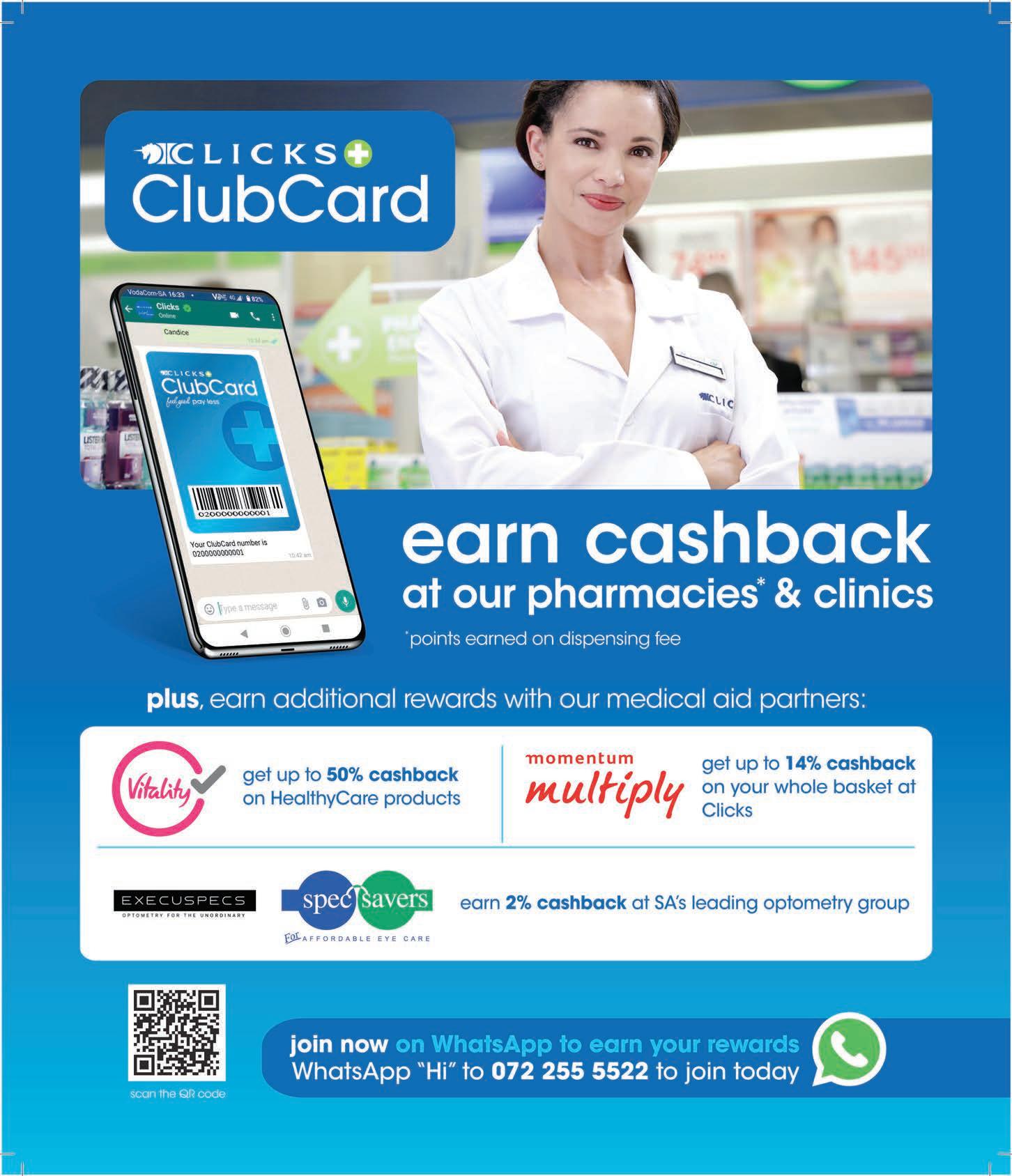




























 Ronwen Williams
Ronwen Williams






























































































































































































